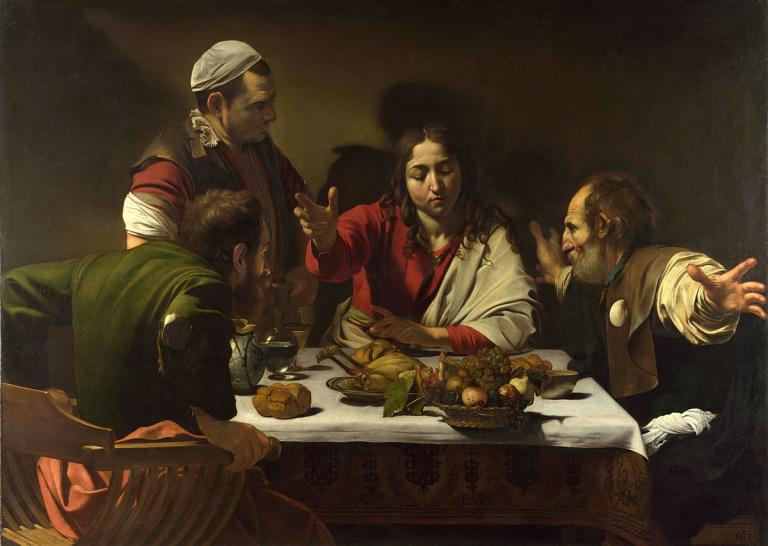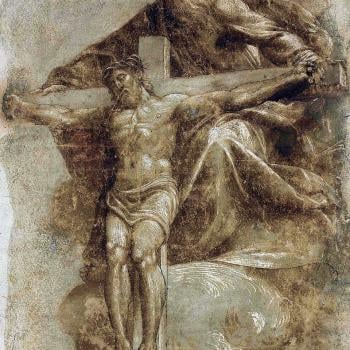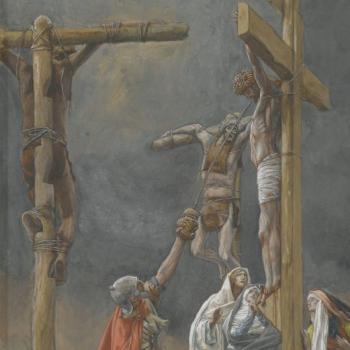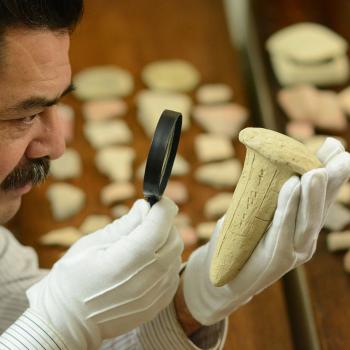
Have you ever pondered the significance in Luke 24 of the resurrected Jesus being revealed to his disciples when he broke bread with them? Here’s the text: “When he was at table with them, he took the bread and blessed and broke it and gave it to them. And their eyes were opened, and they recognized him. And he vanished from their sight” (Luke 24:30-31; ESV). Then and now, the resurrected Jesus breaks through and reveals himself to us when we break bread together.
You may recall the context for this text. Two of Jesus’ disciples were walking along on the road to Emmaus and discussing Jesus’ crucifixion as well as the flash news report that Jesus had been raised from the dead. Little did they know, but the stranger who walked up alongside them and joined in their conversation was none other than Jesus. The text simply tells us: “While they were talking and discussing together, Jesus himself drew near and went with them. But their eyes were kept from recognizing him” (Luke 24:15-16; ESV). What was it about the breaking of bread that led the disciples to recognize Jesus? And what difference does this text make for us today in view of the resurrection?
To answer these questions, we will first account for what David Lertis Matson and others have pointed out about the centrality of bread in Jesus’ day as well as in the church. As Matson notes, bread, like salt, was critically important to people’s sustenance. Matson also makes clear the thematic significance of breaking bread in Luke’s two canonical books—the Gospel of Luke and the Acts of the Apostles. Matson goes so far as to claim that
it is Luke among the writers of the New Testament for whom “breaking bread” becomes a “classic” way of referring to the Lord’s Supper (Luke 9:16; 22:19; 24:30, 35; Acts 2:42, 46; 20:7,11; 27:35). Of the many references listed here, the meal scene embedded in the story of Emmaus (24:13-35) is the most theologically charged: only after Jesus instructs the two disciples on the road to Emmaus and breaks bread in their house are they able to recognize the risen Lord in their midst (24:30). At story’s end, Luke summarizes the entire sequence of events thusly: “Then they told what had happened on the road, and how he had been made known to them in the breaking of the bread” (24:35)…As the climax to the first of Luke’s two volumes (Luke 1:1-4; Acts 1:1), the Emmaus narrative occupies a strategic “pivot” position, allowing the reader to look “backward” to the table fellowship practice of Jesus in the Gospel of Luke and “forward” to the depiction in Acts of believers breaking bread in their homes.[1]
We find in this explanation the answer to the first of our questions above, namely, “What was it about the breaking of bread that led the disciples to recognize Jesus?” Jesus had made quite clear, as did Luke, that table fellowship was constitutive of Jesus’ way of being and misison in the world. We truly see Jesus in this humble act of fellowship.
Two other claims stand out to me in Matson’s article. They will help us address the second question above, namely, “What difference does this text in Luke 24 (and related biblical texts) make for us today in view of the resurrection?” One is Matson’s claim that “The New Testament bears ample witness to the fact that the earliest struggles of the church involved matters of table fellowship.”[2] The other is Matson’s reflection that “When we gather together to celebrate the Lord’s Supper, we must do so with the firm conviction that the risen Lord is present with us, revealing himself to us. Like the disciples at Emmaus, our prayer must always be: ‘Stay with us, because it is almost evening and the day is now nearly over.’ For when we do, we continue to encounter the ever present one in the breaking of the bread.”[3]
Now it should hardly come as a surprise that the early church’s struggles involved problems with table fellowship given the essentially and radically inclusive nature of their meals. Old barriers were removed, including between Jews and Gentiles. Refer here to Paul’s rebuke of Cephas for separating himself from table fellowship with Gentile believers in Antioch in the presence of the visiting Jewish circumcision party from Jerusalem (Galatians 2:11-14). The same is true for divisions between Hellenistic Jews and Hebraic Jews. Refer here to the Apostles’ determination to overcome the blatant disregard of Hellenistic widows in the daily distribution of food in Jerusalem (Acts 6:1-7). We find the same dynamic at work in overcoming divisions involving haves and have-nots, that is, people of different classes. Refer to Paul’s challenge to the Corinthian church for the well-to-do separating themselves from those of lesser means during the Agape feast in Corinth (1 Corinthians 11:17-34).[4] Matson’s quotation from Philip Francis Esler on Luke’s eucharistic theology has a bearing on all such divisions, not just Jew and Gentile, namely Esler’s attentiveness to “Luke’s persistent emphasis on the fact that the old barriers between Jew and Gentile have been decisively shattered in the eucharistic fellowship of the Christian community and that an era of salvation for all humanity has now been inaugurated, even if there are some who do not yet realize it.”[5]
Should we be surprised that we have a hard time seeing and experiencing the risen Jesus if and when we do not have table fellowship with fellow believers, or if we live as if the old barriers between us have not been removed? Yes, Jesus is revealed in the breaking of the bread (Luke 24:30-31, 35). And yes, the old barriers “have been decisively shattered” between us through Jesus’ eucharistic meal that remembers and celebrates his death, burial, and resurrection. But still, we must live into this new reality if we are to see and experience the resurrected Jesus as he truly is! May we no longer live as if we are blind to this realization. May we who are from all walks of life come together as Jesus’ people at his feast. May we live in expectation that Jesus’ resurrected glory breaks through to us as we break down these barriers wherever we find them in the church today.[6]
_______________
[1]David Lertis Matson, “Breaking the Bread, Breaking the Veil: Recognition of Jesus at Emmaus,” Leaven, vol. 3/3 (1995): 8.
[2]Matson, “Breaking the Bread, Breaking the Veil,” page 10.
[3]Matson, “Breaking the Bread, Breaking the Veil,” page 12.
[4]According to Gordon Fee, the Lord’s Supper was probably part of a common meal. The ‘haves’ and ‘have-nots’ were likely divided during this celebration, as it was “sociologically natural for the host to invite those of his/her own class to eat” in the dining room. Those not of their class (the less fortunate here in Corinth) ate in the courtyard. Gordon D. Fee, The First Epistle to the Corinthians, The New International Commentary on the New Testament, vol. 7 (Grand Rapids: Eerdmans, 1987), pages 533-534.
[5]Philip Francis Esler, Community and Gospel in Luke-Acts: the Social and Political Motivations of Lucan Theology (Cambridge: Cambridge University Press, 1987), page 104; quoted in Matson, “Breaking the Bread, Breaking the Veil,” page 12.
[6]I address this theme at length in my volume, Consuming Jesus: Beyond Race and Class Divisions in a Consumer Church (Grand Rapids: Eerdmans, 2007).












